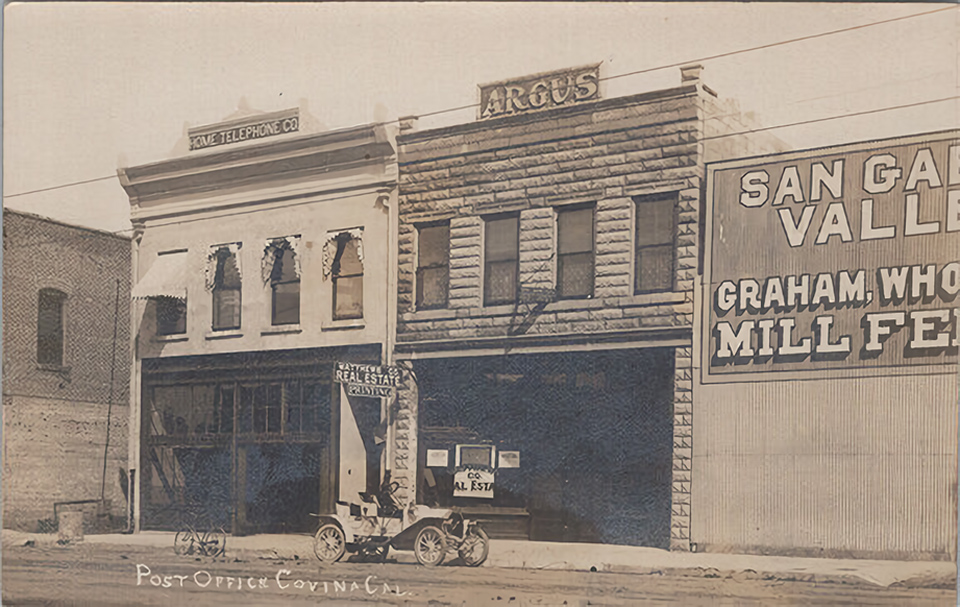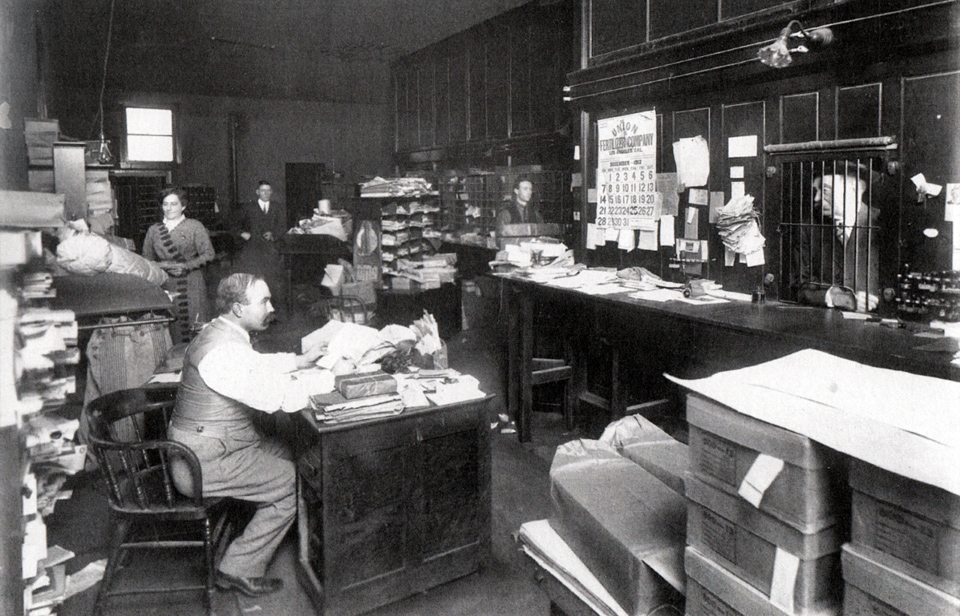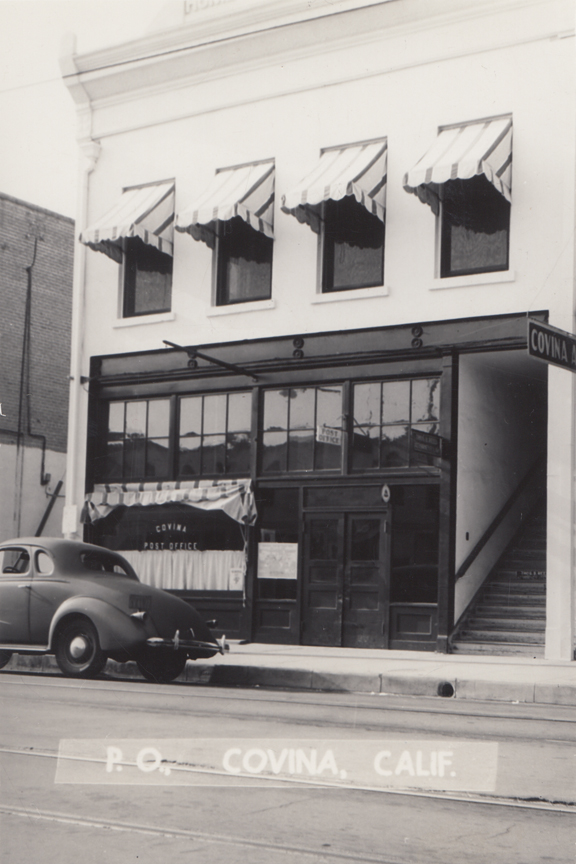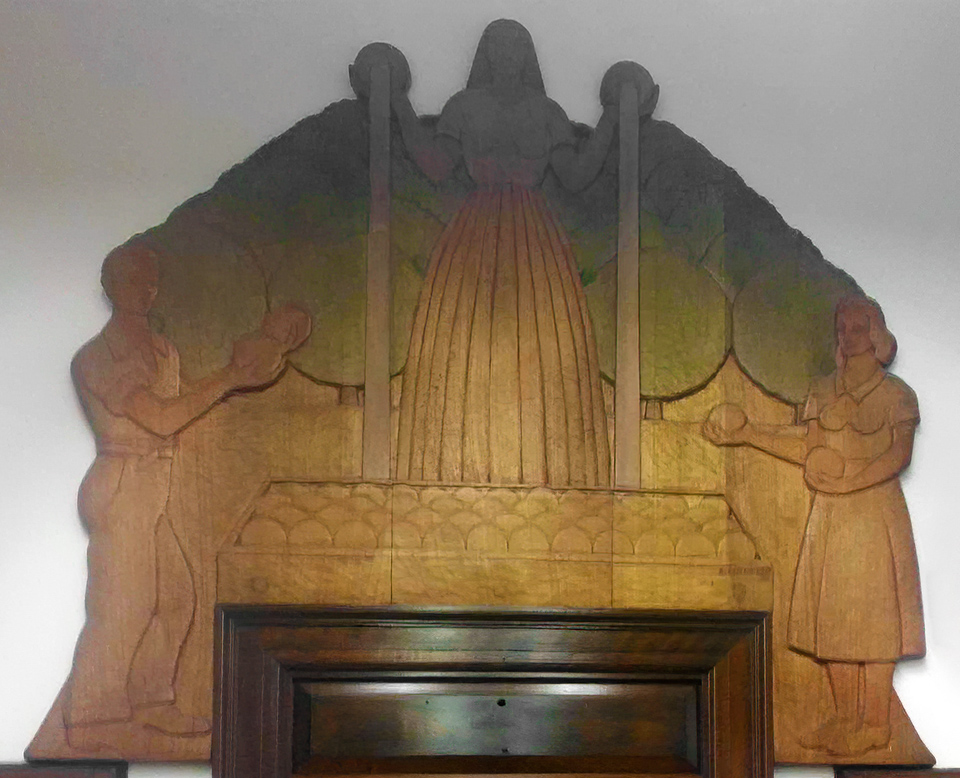These adjacent buildings at 117-121 East Badillo once comprised the communications hub of the city: the post office, the telephone company, and the hometown newspaper, all within a few steps of each other.

The Home Telephone building (1906)1 and the plant of the Covina Argus (1907)2 in Fall, 1908.
Although this post office was less than a half block from the main street, that was the extent of its convenience, because before 1918, there was no such thing as home delivery.3 People had to go into town and pick up their mail in person.

Postmaster Matthews at his desk, December, 1913.
Courtesy Covina Valley Historical Society, reproduced from Hall, B. A. (2007), p.81.4
A true pillar of the community for half a century, James Lewis "Louie" Matthews (1871-1945)5 was postmaster from 19036 to 1915, but he is best remembered as the owner/editor/publisher of the Covina Argus newspaper; his long tenure there extending from 1895 to his dying day.3 (I mention Matthews only in passing now, but the man is certainly worthy of an article in his own right.)

By the Thirties, Covina had grown substantially, but as you can see above, the post office didn't keep pace. In 1936, recognizing the need, Chamber of Commerce president James G. Hodges, Jr. personally lobbied Washington for an expanded facility.3 His and others' efforts finally bore fruit, and the new federal post office at 170 East College Street so familiar to most of us opened for business on May 6, 1940.7


In the lobby is displayed the cedar New Deal relief sculpture "Covina Desert Orange Groves" by Atanas Katchamakoff (1941). Photo by Glenn Reed, 2016.
Following is an article about the dedication of the 1940 facility, and the history of the Covina post office in general:
Pomona Progress-Bulletin, Monday, April 29, 1940.7
COVINA, April 29.–Official dedication of Covina's new postoffice building is being arranged for Saturday afternoon, May 4, at 3 o'clock, according to announcement of Postmaster George Meek. As Congressman Jerry Voorhis has returned from Washington, it is hoped that he will be able to take part in the ceremonies. The program is to include talks by Charles Anderson, who has spent fifty years in the mail service, C. B. Voorhis, father of Congressman Voorhis, Mayor S. I. Colver and other city officials.
C. W. Potter, resident of Covina for more than 50 years, has accepted an invitation to give a historical sketch. The letter-carriers' band of Los Angeles and the local high school band will provide music for the occasion. A large delegation of Southern California postal officials are expected to be in attendance.
The steamship bringing the furnishings and equipment for the new postoffice from the Eastern coast was grounded a hundred miles south of Mexico City several weeks ago but a re-order shipment is expected to arrive from Philadelphia and be installed in time for the dedication. The building itself has been finished for several weeks and workmen have been landscaping the grounds.
Appropriate ceremonies marking the breaking of the ground for the new postoffice building were held August 7, 1939, after the contract had been let to George Goedhart, San Diego contractor. The complete structure and equipment represents a federal investment of $52,000. Specifications called for a concrete, one-story building, 73 by 71 feet with basement. Ornamental iron grill over sun-proof glass windows, interior marble finish and composition roof. The new postoffice, oldtimers recall, is a marked advance from the time when residents of Covina first got their mail once a week from Puente where the Southern Pacific deposited mail sacks for the entire valley.
When the Santa Fe branch was built thru Azusa in 1887, the Covina mail was brought over from that point by horseback carriers, some of whom were Captain Gordon, Mr. Eckles, father of Arthur Eckles, and Ed Prather.
The first postoffice for Covina was located in the Gene Griswold home at the corner of Citrus and Cypress avenue, a short distance from the first schoolhouse. After a few years it was moved to the Eastman grocery store at the corner of Citrus avenue and Badillo street and Mr. Wellington was appointed postmaster. Tom Griswold followed Wellington in the local postal service, then J. L. Matthews, Daniel F. Stafford, W. P. Nye and George Meek.
Mail delivery service was inaugurated in Covina some 25 years ago while Mr. Stafford was postmaster.
With the exception of two custodians not yet appointed, the staff will remain the same as at present. They are Elin S. Anderson, assistant postmistress, Miss Nellie Anderson, Glenn White, Clark R. McCall, clerks, and Postmaster Meek. Martin Hohman, Roy Spangler, John F. Krohn and John C. Hutchinson Jr., will continue as city carriers; J. F. Berry, Richard Jackson, as rural carriers; and Merle Layman, as mail messenger.
The new federal building is centrally located, at the corner of College and 2nd streets, a short distance from the Covina City hall, the Covina public library, the Edison building, the Southern Counties Gas company's office and the Associated Telephone company's headquarters for Covina.


Envelope addressed by Col. Frank Chapman (1849-1909), postmarked Covina, 1899. In that year, the post office was in a tailor's shop at 111 North Citrus.8

References:
1 Covina Argus, March 23, 1907, p.8.
2 Covina Argus, October 5, 1907, p3.
3 Pflueger, D. H. 1964. Covina: Sunflowers, Citrus, Subdivisions. Castle Press, Pasadena, California, 372pp.
4 Hall, B. A. 2007. Covina (Images of America). Arcadia Publishing, San Francisco, California. 127pp.
5 James Lewis Matthews, Find a Grave memorial.
6 Covina Argus, January 9, 1903, p.1.
7 Pomona Progress-Bulletin, April 29, 1940, p.5.
8 Sanborn-Perris fire insurance map, October, 1899, Library of Congress.
No comments:
Post a Comment
To post a comment, you must login to this page with the Google Chrome web browser. That is the only way that works now.